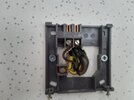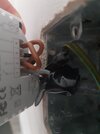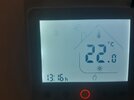@Taylortwocities has given you the answer, however do consider what the thermostat does, the wall thermostat can have two completely different jobs but look the same.
1) Is to control the temperature of the room.
2) Is to turn boiler up/down or on/off as required.
They may seem the same, however with a modern gas boiler we control room temperature in the main with the thermostatic radiator valve (TRV) which is analogue, and the return water controls boiler output which again is analogue, we can link the TRV to a hub or thermostat which is in turn connected to the boiler ebus, OpenTherm is most popular, but if we try to control boiler output using a mark/space ratio (digital) it can defeat the analogue controls.
The modern gas boiler will have a sweet point at which it is most economical and this is unlikely to be when running flat out, and when it switches off any heat in the boiler is sent out of the flue and wasted, so the idea is to allow the boiler to modulate first, so not as hot when it finally does switch off, so less heat is lost when it does switch off, so main control is with the TRV heads, the wall thermostat is there to switch off boiler when there is a change in the required temperature or when the weather improves, not to control room temperature directly.
So a very cheap on/off hard wired wall thermostat even the programmable type will turn off the heating on warm days or when there is a change in temperature requirement like going out or going to bed, and of course back one when on your way home or about to get up. But if it tries to use a mark/space ratio (that means switching it on and off on a regular basis) which is used to stop oil and electric central heating from over shooting, it will use more gas as it keeps the boiler running flat out each time it is on, and defeats the condensing software of the boiler.
I had the
Honeywell Y6630D1007 Wireless Room Thermostat in the last house, a very good thermostat, but not suited to a modulating gas boiler, it would have been A1 in this house with oil. So will gas modulating boilers the very cheap are OK to stop cycling in warm weather and the expensive are OK, but the mid range tend to use the mark/space ratio, so as the target temperature is approached it starts to switch the boiler off/on to ensure it does not over shoot, and this wastes gas, where the expensive even when using on/off control work out when to turn off using built in algorithms so they don't cycle the boiler. As an example we have Nest.
There are other methods Nest can also use OpenTherm and it turns boiler up/down not on/off, Hive is an odd one out, it uses demand for heat so the Hive TRV heads tell the wall thermostat to stay on if any room is still below set point, Drayton have TRV heads which work out when to close to stop over shoot so are faster getting room to temperature, as some of the electronic TRV heads have rather too much anti-hysteresis built in so are slow getting room to the last couple of degrees. But we are looking at expensive systems with the likes of EvoHome, Drayton Wiser, Tado etc.
You can get nearly the same with a cheap wall thermostat and cheap stand alone programmable TRV heads like the eQ-3, and any wifi switch can turn heating on/off with geofencing, however not found geofencing that good, yes it works, can't say it doesn't, but out of the house for 10 hours and with heating off it drops maybe 6°C and on return it will warm up the first 4°C quite rapid, but the anti-hysteresis software in the TRV heads means the Nest Gen 3 thermostat can't warm up house that last 2°C, so using a timed schedule I can set the temperature to 2°C higher for an hour then down to wanted temperature which speeds up reheating, so it is at temperature required when I get home. Nest Gen 3 would likely do it OK if I did not have programmable TRV heads also set to geofence with IFTTT, so now use simple scheduled temperature changes. And with the eQ-3 TRV heads which are not wifi, only bluetooth, but only £15 less for non blue tooth I have set each room with slight delay, so kitchen heats first, then the dinning room, and then the living room and finally the bedrooms which means rooms heat faster, and unused rooms not heated. All this does not tie in with geofencing. I am sure Drayton Wiser would work, but if you price it up, you will see why I have not fitted it.
So if using a very old boiler or oil then that thermostat will likely work well, if using a modern gas boiler, then that thermostat from what I read uses a mark/space anti-hysteresis system so will work, but not in an economic way.









